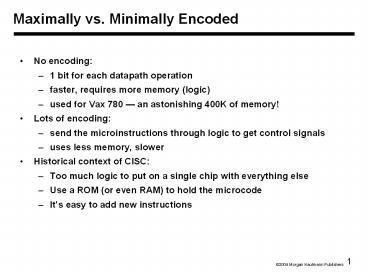No%20encoding: - PowerPoint PPT Presentation
Title:
No%20encoding:
Description:
faster, requires more memory (logic) used for Vax 780 an astonishing 400K of memory! ... send the microinstructions through logic to get control signals. uses ... – PowerPoint PPT presentation
Number of Views:38
Avg rating:3.0/5.0
Title: No%20encoding:
1
Maximally vs. Minimally Encoded
- No encoding
- 1 bit for each datapath operation
- faster, requires more memory (logic)
- used for Vax 780 an astonishing 400K of memory!
- Lots of encoding
- send the microinstructions through logic to get
control signals - uses less memory, slower
- Historical context of CISC
- Too much logic to put on a single chip with
everything else - Use a ROM (or even RAM) to hold the microcode
- Its easy to add new instructions
2
Microcode Trade-offs
- Distinction between specification and
implementation is sometimes blurred - Specification Advantages
- Easy to design and write
- Design architecture and microcode in parallel
- Implementation (off-chip ROM) Advantages
- Easy to change since values are in memory
- Can emulate other architectures
- Can make use of internal registers
- Implementation Disadvantages, SLOWER now that
- Control is implemented on same chip as processor
- ROM is no longer faster than RAM
- No need to go back and make changes
3
Historical Perspective
- In the 60s and 70s microprogramming was very
important for implementing machines - This led to more sophisticated ISAs and the VAX
- In the 80s RISC processors based on pipelining
became popular - Pipelining the microinstructions is also
possible! - Implementations of IA-32 architecture processors
since 486 use - hardwired control for simpler instructions
(few cycles, FSM control implemented using PLA
or random logic) - microcoded control for more complex
instructions (large numbers of cycles, central
control store) - The IA-64 architecture uses a RISC-style ISA and
can be implemented without a large central
control store
4
Pentium 4
- Pipelining is important (last IA-32 without it
was 80386 in 1985) - Pipelining is used for the simple instructions
favored by compilersSimply put, a high
performance implementation needs to ensure that
the simple instructions execute quickly, and that
the burden of the complexities of the instruction
set penalize the complex, less frequently used,
instructions
Chapter 7
Chapter 6
5
Pentium 4
- Somewhere in all that control we must handle
complex instructions - Processor executes simple microinstructions, 70
bits wide (hardwired) - 120 control lines for integer datapath (400 for
floating point) - If an instruction requires more than 4
microinstructions to implement, control from
microcode ROM (8000 microinstructions) - Its complicated!
6
Chapter 5 Summary
- If we understand the instructions We can build
a simple processor! - If instructions take different amounts of time,
multi-cycle is better - Datapath implemented using
- Combinational logic for arithmetic
- State holding elements to remember bits
- Control implemented using
- Combinational logic for single-cycle
implementation - Finite state machine for multi-cycle
implementation
7
Chapter Six
8
Pipelining
- Improve performance by increasing instruction
throughput - Ideal speedup is number of stages in
the pipeline. Do we achieve this?
Note timing assumptions changedfor this
example
9
Pipelining
- What makes it easy
- all instructions are the same length
- just a few instruction formats
- memory operands appear only in loads and stores
- What makes it hard?
- structural hazards suppose we had only one
memory - control hazards need to worry about branch
instructions - data hazards an instruction depends on a
previous instruction - Well build a simple pipeline and look at these
issues - Well talk about modern processors and what
really makes it hard - exception handling
- trying to improve performance with out-of-order
execution, etc.
10
Basic Idea
- What do we need to add to actually split the
datapath into stages?
11
Pipelined Datapath
- Can you find a problem even if
there are no dependencies? What instructions
can we execute to manifest the problem?
12
Corrected Datapath
13
Graphically Representing Pipelines
- Can help with answering questions like
- how many cycles does it take to execute this
code? - what is the ALU doing during cycle 4?
- use this representation to help understand
datapaths
14
Pipeline Control
15
Pipeline control
- We have 5 stages. What needs to be controlled in
each stage? - Instruction Fetch and PC Increment
- Instruction Decode / Register Fetch
- Execution
- Memory Stage
- Write Back
- How would control be handled in an automobile
plant? - a fancy control center telling everyone what to
do? - should we use a finite state machine?
16
Pipeline Control
- Pass control signals along just like the data
17
Datapath with Control

























